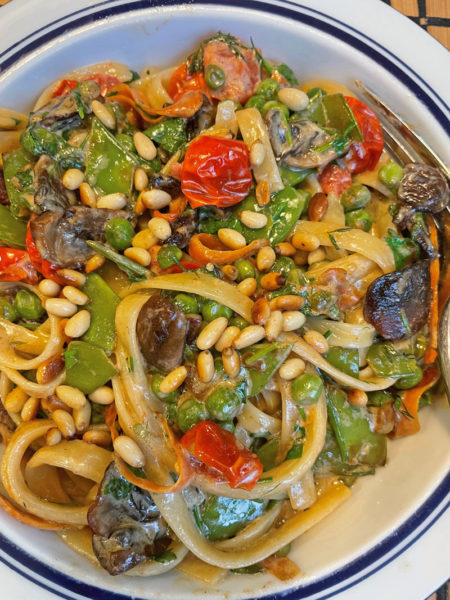Primavera in Italian means springtime and as designation for a recipe, means more colorful springtime fare for the table. The crabapple outside our kitchen window has burst into a pink cloud of blossoms, affirming that it is time to look for recipes that embody a seasonal change in the menu.
Pasta Primavera’s Italian origins call for pasta made in a cream sauce with parmesan cheese and herbs. It came to fame in America in the 1970s, when the fashionable French restaurant Le Cirque, introduced it on its menu in New York. In its American debut the dish acquired a more colorful appearance with green vegetables and a sprinkling of pine nuts and rapidly gained popularity with many chefs.
I remember being introduced to it in the late ‘70s by Chef Tell, who at that time presided over the Chestnut Hill hotel in Philadelphia. The following recipe for four has evolved from that time and can vary depending on the vegetables on hand.
Pasta Primavera

Pasta Primavera (Photo courtesy Ilga Winicov Harrington)
Toast 2 tbsp raw pine nuts for two minutes in an ungreased pan until light brown spots appear. Set aside.
Cook 8-10 ounces fettuccine in a large pot of water with 1 tsp salt to al dente as indicated on the package. Before draining reserve a cup of the cooking water, drain and set aside.
While the pasta is cooking, heat 1 tbsp grapeseed oil in a large skillet over high heat and cook 10 sliced mushrooms for four minutes and set aside.
In the same skillet heat another tbsp grapeseed oil and saute two chopped garlic cloves, ½ carrot cut in slivers with a vegetable peeler, 20 snow peas with the tough string removed from the side and sliced in diagonal in three pieces, 1 cup defrosted green peas, 1 cup tender asparagus spears, cut in 1-inch pieces (optional), ½ tsp salt and ¼ tsp pepper for four minutes. Add the cooked mushrooms and 10 halved cherry tomatoes and cook for an additional minute.
Prepare the cream sauce by melting 2 tbsp butter in a small pan, add ¾ cup thick cream and ½ cup grated fresh Parmigiano Reggiano. Heat while stirring until the cheese is melted.
Set the pasta cooking pot back on medium heat. Return the pasta, vegetables and cream sauce to the pot, toss to heat and stir in 1/3 cup pasta water. Toss while heating for 1-2 minutes until sauce is thick and coats the pasta. Finally toss with ½ cup herbs: mixture of chives, Italian parsley and dill or fresh basil. Serve hot with a green salad.
Everyone loves chicken cutlets Parmigiana. For lighter spring fare Chicken Paillard is a welcome alternative and has the added virtue of being gluten free. Paillard is the French way of describing boneless butterflied or thinly pounded slices of meat, that are quickly fried with a flavorful sauce. This recipe also has evolved over time in my kitchen.
Chicken Paillard

Chicken Paillard (Photo courtesy Ilga Winicov Harrington)
Slice skinless boneless chicken breast in less than ½ inch slices and pound thin between sheets of plastic wrap. Lightly salt and pepper each piece of meat.
Start oven and set to 150 degrees and have ready a pan lined with parchment. Fry chicken in batches. In a large skillet heat 2 tbsp grapeseed oil just before smoking and quickly fry the chicken slices for 2-3 minutes on each side to lightly brown. Set done pieces on parchment lined pan to keep warm in the oven, while you finish the rest.
In a small bowl mix: 1 tbsp grainy Dijon mustard, 2 tsp small capers, 2 tbsp fresh lemon juice, 1 tbsp red wine vinegar and six quartered large green olives. Heat 1 tbsp grapeseed oil in the pan used to fry chicken and sauté two chopped cloves of garlic for one minute, stir in the mustard sauce and cook for another minute.
Remove chicken to a large, rimmed plate, spoon the hot sauce over it and sprinkle with chopped Italian parsley. Serve hot with buttered noodles and vegetables.
To quote Lilly Pulitzer: “Despite the forecast, live like it’s spring!”
(I. Winicov Harrington lives in coastal Maine and is the author of “How to Eat Healthy and Well for Less than $5.00 a Day: the Smart-Frugal Food Plan”; website: winicov-harrington.com).



